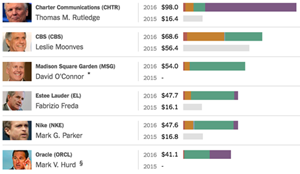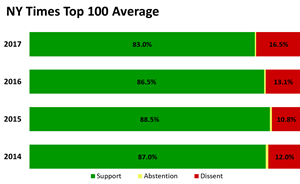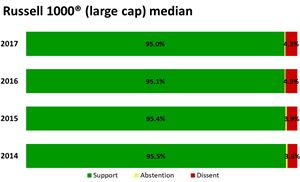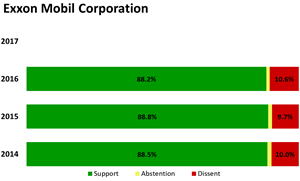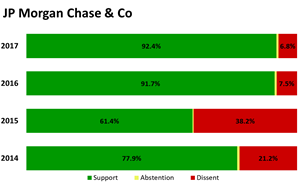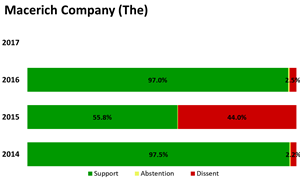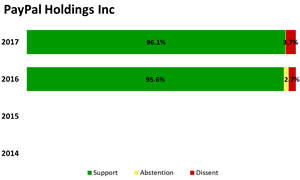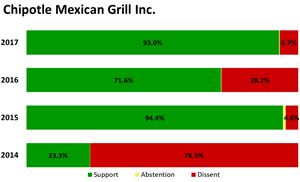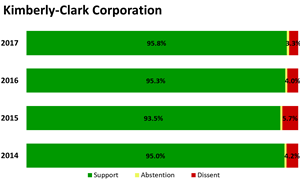
Business Day
The Trump Effect on
C.E.O. Pay
Fair Game
By
GRETCHEN
MORGENSON
MAY
26, 2017
|
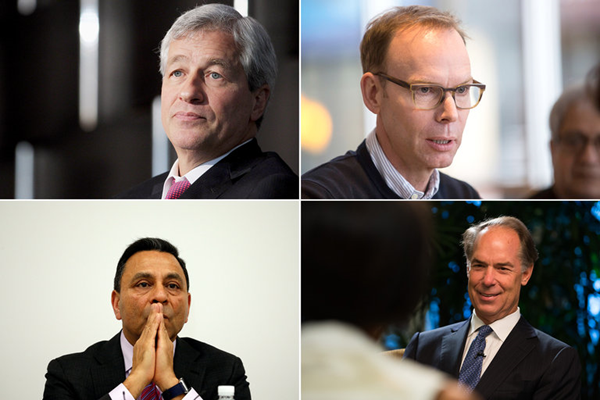
TClockwise from top left: Jamie
Dimon of JPMorgan Chase, Steve Ells of Chipotle Mexican Grill,
Gerald L. Hassell of Bank of New York Mellon and Dinesh C.
Paliwal of Harman International Industries.
Clockwise from top left: Mario Tama/Getty Images; Stephen
Brashear/Associated Press; SeongJoon Cho/Bloomberg; Kim Hong-Ji/Reuters |
After
the November election, the stock market experienced a Trump bump. The
surge in share prices thrilled investors, but some corporate
executives had even more reason to celebrate. That’s because rising
prices can fuel higher pay even if other corporate results are so-so,
which seems to be the case for some companies right now.
Consider
Equilar’s rankings of the
top 200 highest-paid C.E.O.s,
compiled for The New York Times. The company in the middle of the list
awarded its C.E.O. $16.9 million, 9 percent more than it did in 2015,
even though median revenues increased only 3 percent.
Total shareholder
returns were explosive — up 14 percent for the median company. A close look at
the numbers suggests that the levitating 2016 stock market was a powerful driver
of C.E.O. pay last year, and the bull market seems to have made shareholders
less likely to complain about the pay increases executives received. Yet there
are serious questions concerning the ties between
executive pay and a company’s stock
performance.
Corporate
compensation committees typically consider stock performance when determining
pay. Another
study by
Equilar, a compensation analysis company in
Redwood City, Calif., found that 57.4 percent of all Standard & Poor’s 500-stock
index companies used total shareholder return, which includes dividends, as a
performance measure for compensation purposes in 2015.
| |
Fair Game
A
column from Gretchen Morgenson examining the world of finance
and its impact on investors, workers and families
See More »
|
| |
|
But calibrating how much weight a stock price should have on C.E.O.
pay is tricky: A company’s stock price can be influenced by share
buybacks and other financial engineering that does little to produce
long-term value. Why reward a C.E.O. for that?
And
sometimes a company’s stock price rises for reasons that are unrelated
to its operating performance. Remember when oil prices were hitting
the stratosphere a decade ago? Executives at companies like
Exxon Mobil reaped enormous pay
awards not just because of able
leadership but also because the escalating value of the commodity
propelled the prices of their stocks.
Something similar
may have happened after last year’s presidential election. Call it the Trump
effect on C.E.O. pay.
By early November,
many stocks were barely up on the year — the S.&P. 500 had eked out a mere 2
percent gain. But after the election, the overall market rallied on expectations
of the incoming Trump administration’s pro-business agenda. The S.&P. 500 wound
up almost 10 percent higher for 2016.
For an outsider,
determining precisely how a company assesses a performance metric is difficult,
of course. But the lift from the Trump effect seems to have been most pronounced
among industries in which investors believed the administration’s deregulatory
fervor would be greatest and thus lead to lower costs and more profits.
The financial
arena is a prime example. Throughout most of 2016, the S.&P. Financial Select
Sector Index bounced around a narrow range, essentially trading flat on the
year. But it took off after the election, soaring to a 20 percent gain by year’s
end. Investor assumptions that the new administration would roll back the
Dodd-Frank Act and generally reduce restrictions on financial activities powered
this move.
There are 31
finance executives on Equilar’s highest-paid C.E.O. list for 2016. Over half of
them — 17 — got raises last year, and each of the 17 companies used shareholder
returns as a metric in determining their pay. Ten of those C.E.O.s received
double-digit increases.
The highest-paid
finance executive was Jamie Dimon, the chief executive of
JPMorgan Chase. His total compensation was
$27.2 million, nearly a 50 percent increase from the $18.2 million he received
in 2015, according to Equilar.
In the top 200
rankings, Equilar relied on standard compensation figures required in proxies by
the Securities and Exchange Commission. JPMorgan supplied those figures, but in
another section of its proxy, it listed Mr. Dimon’s pay as $28 million in 2016
and $27 million in 2015, so according to the financial firm, Mr. Dimon’s pay
increased by just $1 million, or nearly 4 percent.
In detailing Mr.
Dimon’s pay, the proxy noted that the bank gained market share in most of its
businesses and generated record net income and earnings per share. The fact that
JPMorgan’s total shareholder return was 35 percent for the year isn’t lost on
investors.
Shareholders seem
relatively content with Mr. Dimon’s package. At the bank’s annual meeting in
mid-May, 92 percent of votes cast approved its pay practices, the same
percentage as last year.
Investors in most
other financial companies did well — only five showed a decline in total
shareholder returns for 2016.
However, while 12
of the finance companies’ shares outperformed the sector stock index, 19 did
not. In spite of this underperformance, 10 of the 19 companies awarded their
C.E.O.s higher pay, and some of the increases were significant.
It looks like a
very sweet game: Heads I win, tails you lose.
One fortunate
chief executive was Arthur M. Coppola, a co-founder of the
Macerich Company, a real estate investment
trust in Santa Monica, Calif. Although revenues at the company fell 19 percent
in 2016 and its shares lost 9 percent, Mr. Coppola received $13.5 million, a 2.6
percent increase over last year.
Thomas O’Hern,
Macerich’s chief financial officer, said the bulk of Mr. Coppola’s pay consisted
of stock grants with three-year earn-out periods based on the company’s
performance against all public real estate investment trusts. “It’s very
unlikely he would end up earning that amount based on where we are today,” Mr.
O’Hern said.
Shareholders are
scheduled to vote on Macerich’s pay practices on Thursday.
Daniel H. Schulman
at PayPal Holdings is another case in point. He received a compensation package
valued at $19 million, a 31 percent increase over 2015. That pay raise far
exceeded growth rates in the company’s sales, which were up 17 percent, and
earnings and shareholder returns, which both rose around 9 percent during the
year.
Amanda Coffee, a
PayPal spokeswoman, said in a statement, “The majority of Dan Schulman’s
compensation is driven by performance; 2016 was an extraordinary year for PayPal
as we delivered results that exceeded our targets and delivered double-digit
growth across all key metrics.”
At the company’s
annual meeting on Wednesday, 95 percent of the votes cast favored PayPal’s
compensation practices.
To be sure, the
Trump bump didn’t push every company’s shares higher in 2016. As the pay
rankings show, though, even a falling tide lifts the boats of some C.E.O.s.
A total of 44
companies on the list had the same C.E.O. in place in 2015 and 2016 and also had
declining shareholder returns. Yet at 23 of these companies, chief executives
received raises in 2016.
Among the bigger
winners in this group was Steve Ells, the chief executive of Chipotle Mexican
Grill. Even as his company’s revenues fell 13 percent and its shares declined by
21 percent, Mr. Ells snared a 13 percent increase in pay, receiving $15.7
million in 2016.
Chris Arnold, a
Chipotle spokesman, said most of Mr. Ells’s raise last year came in the form of
stock grants. “The 2016 award will not vest and therefore will be completely
without any realizable value,” he said, “unless our stock price reaches an
average of $700 per share for a period of at least 60 consecutive trading days
before February 2019.”
Mr. Arnold added
that a 2013 grant, originally worth $8 million, had no value when it expired in
2016.
Mr. Ells’s
compensation has come under fire from shareholders before; at last year’s annual
meeting, 28.2 percent of the
votes cast opposed Chipotle’s pay practices.
However, during this year’s annual meeting, held on Thursday, votes against the
practices totaled only 6 percent.
Then there’s
Kimberly-Clark’s C.E.O., Thomas J. Falk. He, too, received a 13 percent increase
in pay, even as sales at his consumer products company fell 2 percent and its
stock lost 7.5 percent.
A Kimberly-Clark
official said that its board believes the most accurate way to measure
longer-term performance is to use multiyear total shareholder returns. “The
company’s three-year return is 24.9 percent and its five-year return is 90.3
percent,” the official said in a statement, “which demonstrates the value that
Kimberly-Clark has delivered to shareholders under C.E.O. Tom Falk’s
leadership.”
Sure enough,
Kimberly-Clark’s shareholders seem content with Mr. Falk’s pay. At the company’s
annual meeting in April, only 3.3 percent of the votes cast opposed its pay
practices.
It’s hard for
investors to think analytically when the market has been rising. That’s
precisely why skepticism about soaring pay is important right now.
A version of this article appears in print on May 28, 2017, on Page
BU1 of the New York edition with the headline: The Trump Effect on
C.E.O. Pay.
© 2017 The
New York Times Company
